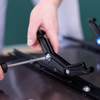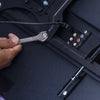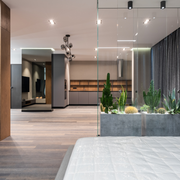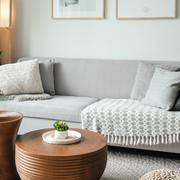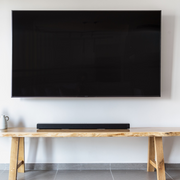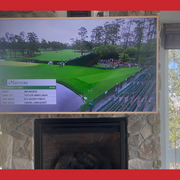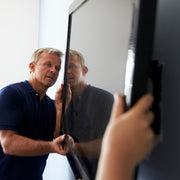Build the Ultimate Backyard Today & Spend More Time Outside: 6 Useful Tips for Mounting Your TV Outdoors

It will come as no surprise that the past couple of years have been on improving living spaces and focused on home improvement. From creating office nooks to relaxing spa updates in the bathroom, three-fourths of Americans painted, retiled, and upgraded their homes to make at-home activities a little easier and more fun.
But home interiors weren’t the only areas to see an influx in improvement projects. Sixty-one percent of homeowners also tackled projects outside — transforming backyards into auxiliary dining rooms, gyms, even living spaces.
Many homeowners created these living spaces by adding in a gazebo or pergola, creating a welcoming space that allows for some partial sun in the summer, while also being safe enough to bring an outdoor heater next to the “living room” for wintertime fun outside. And this trend of great outdoor living spaces doesn’t seem to be going anywhere soon.
One of the key elements of any living space is a great TV, but not all TVs can be used outside. Find out how you can build the backyard of your dreams with these tips for mounting a TV outdoors.

Buy an Outdoor TV or Place an Old TV in a Weather Resistant Cabinet
Sometimes, upgrading the inside of your home presents an opportunity to upgrade the outside as well. For one, it could be a great time to upgrade your TV. If you’re in the market for a new TV for your living room, consider installing the old TV outside. In the likely event that the old TV isn’t weather resistant or weatherproof, you can place your indoor TV in a weatherized cabinet.
TV cabinets and covers come in different grades of weather resistance and waterproofing. For instance, a cover with an IP55 grade offers protection from water and dust. An IP44 grade, on the other hand, will only protect against particles larger than 1mm and may not be suitable for weather conditions like rain and snow.
If you’re an experienced DIY-er, you can build your own weatherized outdoor TV cabinet and then use a MantelMount TV wall mount to get the job done. When installed correctly, our AB40 Bracket serves as a necessary horizontal adapter, providing a 90-degree bridge between the mount's wall plate and the TV mount lifting arm. This allows the wall plate to lay flat on a horizontal surface such as a large shelf or inside a recessed alcove — like your new weatherized TV cabinet!
Using MantelMount, you'll even be able to pull the TV outside of the cabinet and down to a lower eye-level if you like!
Mount Your TV in a Covered Patio
Whether you’re using an old TV or purchasing a new outdoor TV, protecting the screen will be of the utmost importance. If you are installing a standard TV outside you may want to consider placing the TV under a covered patio. This will provide protection by giving the television full shade while also giving you the feeling of a home living room vibe within your semi-outdoor space.
For even more protection for your TV, or if you mount a TV in an area that is uncovered, there are a few options for weatherized TV shields available to buy that are on the market.
Standard indoor TVs have certain environmental requirements to operate correctly. Most indoor TVs need to be kept in environments with low humidity — between 35 and 50%. This makes most TVs unsuitable to mount on an exterior wall of your home.
If you end up installing and mounting a TV outside that was made for indoor use, keep in mind any warranty terms and conditions. This will likely bring peace of mind so if something shorts out or something ends up not working properly, you are able to properly address the issue.
With that being said, installing an outdoor TV gives you more placement flexibility. In which case, you may just need to accommodate the strength and material of the wall before mounting.
Mounting into a brick wall, for example, requires the wall to be able to bear 5 times the weight of your TV. Sunlight and inclement weather conditions will need to be another factor to consider if you can’t place your TV in the shade or may be close to any precipitation.
Consider an Intentionally-Made Outdoor TV Wall Mount
We’ve established that you’re looking for that home theater-like experience... but outside. There’s something to be said by following our tips like keeping cables short and having a great surround system, but it will likely be unfortunate if you are unable to mount the TV.
That’s why, with our WeatherMounts by MantelMount, you can enjoy the lapping of the waves in the pool from the breeze at dusk, the crackling of the fire pits, and your outdoor television showing your favorite TV show (or movie or sports game) while the TV is mounted on a specially-made outdoor TV mount.
With all of the parts and hardware of the mounts made from Marine Grade 316 Stainless Steel, you can be rest assured that you’ll receive all of the same benefits of a MantelMount with our WeatherMounts.

Pick an Exterior Wall That Faces South
Once you decide to build a TV cabinet or purchase a high quality cover, you next need to decide where to place your TV in your backyard oasis. You may already have the perfect exterior wall in mind, but if it’s in direct sunlight, you may never even see what’s on your screen — especially if you’re appropriating an indoor TV for outdoor use.
Outdoor TVs are built with higher levels of brightness than standard indoor TVs. A typical outdoor TV has an NIT count of between 1000 to 2000. Compare that with the standard NIT count of an indoor TV, 250 to 350, and you can see why sunlight can have such an impact on an outside TV-viewing experience.
If you can’t place the TV in shade, mounting a TV on an exterior wall that faces south is the next best thing. Why? By placing an outdoor TV with its back facing south, the sun will be behind the TV throughout a majority of the day. This will reduce glare that you might experience from direct sunlight.
Think About Speaker Placement
Second to a high quality picture is high quality sound. Consider the type of sound experience you want to create. (Remember: the sound will carry outside!) Is it surround sound in which the soundscape moves from front to back? Or a more front-focused sound with height and width variation, like in 9- and 11- surround sound systems?

9- and 11- Speaker Channels
To create a 9- and 11- channel experience, place waterproof external speakers 40-45° off-axis from the seating area. Install the speakers approximately 8ft off the ground and tilt the speakers down. This will introduce height to your soundscape.
Then, place another set of speakers 60° off-axis low on the ground or relative to the viewer’s seated height. This will distribute sound on a horizontal plane. Together, the combination of high and low speakers placed at an angle create a captivating sound experience.

Creating Surround Sound
We’re all familiar with the theater-like quality of a surround sound system. To achieve this, place speakers 25-30°, 90-110°, and 135-150° off-axis. This will create a 360° sound experience for immersive viewing.
For sound systems that aren’t mounted, you can search for speakers that resemble rocks and place them on the ground around a garden. This will integrate your sound system into the surroundings, allowing you to enjoy your garden by day and your favorite films for weekend movie nights.
Keep Cables Short
Just as it’s important to baby proof TV wires, it’s also important to protect cables from the elements and, naturally, you may even be wondering how to run cable to an outdoor TV. Antenna and CAT cables are typically used in outdoor TV setups due to their length. However, most TVs will require this type of wire to feed into an HDMI converter. If you want to fortify these cables from the elements further, feed them through pipe coverings or conduit.
Another effective way to run cable to an outdoor TV is to use a drip loop. Instead of running cables in a straight line, like with an indoor TV, drip loops place the excess wire in a circle. This gives water a chance to drip off the wire onto the ground, preventing water damage.
Creating the best TV viewing experience is central to MantelMount’s creed. That’s why every MantelMount TV wall mount and WeatherMount is built with safety and quality standards to create the best TV-viewing experience and environment. For more tips like these check back for more helpful TV mounting advice from the experts at MantelMount.
